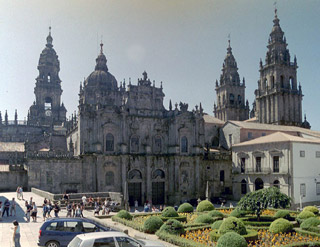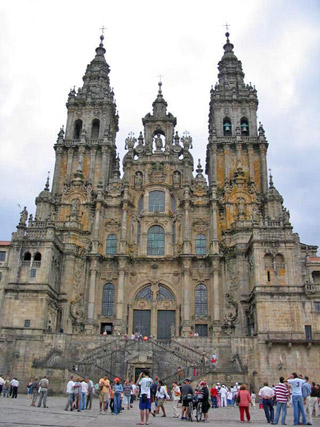Собор Святого Якова


Кафедральный собор Святого Якова в городе Сантьяго-де-Компостелла. Этот собор является не только самой большой романской церковью в Испании, но и одной из крупнейших романских построек в Европе. Построен на месте обнаружения захоронения одного из учеников Христа как место хранения мощей и поклонения им. Строительство началось в 1211 г. и продолжалось еще 400 лет. К его окончанию собор приобрел черты стиля барокко. Один из самых прекрасных соборов мира по-прежнему остается важной христианской святыней, а его уникальность состоит в том, что собор прекрасно просматривается со всех сторон - паломникам он был виден задолго до окончания пути.
Кафедральный собор — выдающийся образец испанского романского зодчества (около 1080—1211); он же — "Портик славы"; в XVII—XVIII веках фасад перестроен в стиле барокко, а также Королевский госпиталь (портал платереско, 1501-11, архитектор Э. де Эгас; перестроен в XVII веке), ныне — отель "Parador de Santiago de Compostela".
Santiago de Compostela Cathedral is situated in Santiago de Compostela in Galicia, Spain. The cathedral is the reputed burial-place of Saint James the Great, one of the apostles of Jesus Christ. It is the destination of the Way of St. James (popularly known by its local denominations: Galician Camiño de Santiago, Portuguese Caminho de Santiago, Spanish Camino de Santiago, French Chemin de St. Jacques, German Jakobsweg, and so on), a major historical pilgrimage route since the Middle Ages.
According to legend, the apostle Saint James the Great brought the Message of Christ to the Celts in the Iberian Peninsula. In 44 AD he was beheaded in Jerusalem. His remains were later brought back to Galicia, Spain. Following Roman persecutions of Spanish Christians, his tomb was abandoned in the 3rd century. Still according to legend, this tomb was rediscovered in 814 AD by Pelayo, a hermit, after witnessing strange lights in the night sky. Bishop Theodemir of Iria recognized this as a miracle and informed the Asturian king Alfonso II (791-842). The king ordered the construction of a chapel on the site. Legend has it that the king became the first pilgrim to this shrine. This was followed by a first church in 829 AD and again in 899 AD by a pre-Romanesque church, at the order of king Alfonso III of León, causing the gradual development of a major place of pilgrimage. This legend was likely a fabrication, used by the kings of Christian Spain to their advantage to expel the Moors from the Iberian Peninsula. In 997 this early church was reduced to ashes by Mohammed ibn-Abi Amir (938-1002), army commander of the caliph of Córdoba, Spain. The gates and the bells, carried by Christian captives to Córdoba, were added to the Aljama Mosque. When Córdoba was taken by king Ferdinand III of Castile in 1236, these same gates and bells were then transported by Muslim captives to Toledo, to be inserted in the cathedral Santa Maria.
Construction of the present cathedral began in 1075 under the reign of Alfonso VI of Castile (1040-1109) and the patronage of bishop Diego Peláez. It was built mostly in granite. Construction was halted several times and, according to the Liber Sancti Iacobi, the last stone was laid in 1122. But by then, the construction of the cathedral was certainly not finished. The cathedral was consecrated in 1128 in the presence of king Alfonso IX of Leon.
According to the Codex Calixtinus the architects were "Bernard the elder, a wonderful master", his assistant Rotbertus and, later possibly, "Esteban, master of the cathedral works". In the last stage "Bernard, the younger" was in charge of the building. He also constructed a monumental fountain in front of the north portal in 1122.
The church became an episcopal see in 1075 and, due to its growing importance as a place of pilgrimage, it was soon raised to an archiepiscopal see by pope Urban II in 1100. A university was added in 1495.
The cathedral has been embellished and expanded between the 16th and the 18th century.
Кафедральный собор — выдающийся образец испанского романского зодчества (около 1080—1211); он же — "Портик славы"; в XVII—XVIII веках фасад перестроен в стиле барокко, а также Королевский госпиталь (портал платереско, 1501-11, архитектор Э. де Эгас; перестроен в XVII веке), ныне — отель "Parador de Santiago de Compostela".
Santiago de Compostela Cathedral is situated in Santiago de Compostela in Galicia, Spain. The cathedral is the reputed burial-place of Saint James the Great, one of the apostles of Jesus Christ. It is the destination of the Way of St. James (popularly known by its local denominations: Galician Camiño de Santiago, Portuguese Caminho de Santiago, Spanish Camino de Santiago, French Chemin de St. Jacques, German Jakobsweg, and so on), a major historical pilgrimage route since the Middle Ages.
According to legend, the apostle Saint James the Great brought the Message of Christ to the Celts in the Iberian Peninsula. In 44 AD he was beheaded in Jerusalem. His remains were later brought back to Galicia, Spain. Following Roman persecutions of Spanish Christians, his tomb was abandoned in the 3rd century. Still according to legend, this tomb was rediscovered in 814 AD by Pelayo, a hermit, after witnessing strange lights in the night sky. Bishop Theodemir of Iria recognized this as a miracle and informed the Asturian king Alfonso II (791-842). The king ordered the construction of a chapel on the site. Legend has it that the king became the first pilgrim to this shrine. This was followed by a first church in 829 AD and again in 899 AD by a pre-Romanesque church, at the order of king Alfonso III of León, causing the gradual development of a major place of pilgrimage. This legend was likely a fabrication, used by the kings of Christian Spain to their advantage to expel the Moors from the Iberian Peninsula. In 997 this early church was reduced to ashes by Mohammed ibn-Abi Amir (938-1002), army commander of the caliph of Córdoba, Spain. The gates and the bells, carried by Christian captives to Córdoba, were added to the Aljama Mosque. When Córdoba was taken by king Ferdinand III of Castile in 1236, these same gates and bells were then transported by Muslim captives to Toledo, to be inserted in the cathedral Santa Maria.
Construction of the present cathedral began in 1075 under the reign of Alfonso VI of Castile (1040-1109) and the patronage of bishop Diego Peláez. It was built mostly in granite. Construction was halted several times and, according to the Liber Sancti Iacobi, the last stone was laid in 1122. But by then, the construction of the cathedral was certainly not finished. The cathedral was consecrated in 1128 in the presence of king Alfonso IX of Leon.
According to the Codex Calixtinus the architects were "Bernard the elder, a wonderful master", his assistant Rotbertus and, later possibly, "Esteban, master of the cathedral works". In the last stage "Bernard, the younger" was in charge of the building. He also constructed a monumental fountain in front of the north portal in 1122.
The church became an episcopal see in 1075 and, due to its growing importance as a place of pilgrimage, it was soon raised to an archiepiscopal see by pope Urban II in 1100. A university was added in 1495.
The cathedral has been embellished and expanded between the 16th and the 18th century.
Изображено на монетах:
Испания, 1 евроцент, 1999+
Испания, 2 евроцента, 1999+
Испания, 5 евроцентов, 1999+